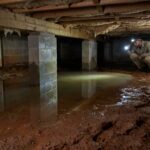Essential Guide to Effective Foundation Repair: Ensuring a Stable Home for the Future
When it comes to your home, the foundation is the unsung hero—holding everything up while also being the most underappreciated part of the whole structure. While the roof may be the crown on your castle, it’s the foundation that keeps the walls standing. If you notice cracks in your walls or doors that stick like they’re auditioning for a soap opera, it might be time to talk about foundation repair. This guide will help you navigate the sometimes murky waters of foundation issues and how to resolve them. So grab a cup of coffee (or tea, we’re not judging), and let’s dive into the essentials of effective foundation repair.
Understanding Foundation Problems
Before we get into fixing the problems, it’s important to understand what can go wrong with a foundation. Here are some common issues that homeowners might encounter:
1. **Cracks in Walls:** These can range from hairline fractures, which are often harmless, to larger cracks that could indicate serious structural issues. Think of cracks as the foundation’s way of saying, “Hey! I could use some attention here!”
2. **Settling and Sinking:** This is when a part of your house begins to sink into the ground. It’s not just your imagination—settling happens over time due to soil movement. Your house might feel like it’s on a permanent tilt-a-whirl attraction.
3. **Bulging or Buckling Walls:** If your walls look like they’re trying out for a modern art installation, it could be due to excessive moisture in the soil surrounding your foundation. Pay attention, because this might signal that your foundation is in distress.
4. **Water in the Basement:** Water intrusion is like an unwanted guest who doesn’t seem to understand that they need to leave. It can lead to mold growth and further foundation deterioration.
5. **Uneven Floors:** If your floor feels more like a funhouse than a stable surface, it could be an indication of underlying foundation issues.
Identifying Foundation Problems Early
You don’t need to be a structural engineer to spot potential foundation problems. Here are some signs to watch for:
– **Interior Signs:** Look for cracks in the drywall, especially around window frames and doorways, or if doors and windows are suddenly hard to open or close.
– **Exterior Signs:** Check for cracks in the foundation itself, especially larger ones. You should also keep an eye on the landscape surrounding your home; if it looks like the earth has shifted, you might have a problem brewing underneath.
– **Moisture Levels:** If your yard is constantly soggy or you see pooling water after rain, it’s a sign that you might be inviting trouble to your foundation party.
To properly assess your foundation’s health, consider consulting with a professional—someone who speaks “builder” fluently. Professional inspections can help determine the cause of any issues and suggest the best course of action.
Foundation Repair Methods
Once you’ve identified foundation issues, it’s time to think about repairs. Depending on the severity of the problem, there are several methods available:
1. **Slabjacking or Mudjacking:** This process involves pumping a mixture of cement, soil, and other materials under the foundation to lift it back into its proper position. Essentially, it’s like giving your house a little boost to help it stand tall again.
2. **Piering:** Installing piers involves driving steel or concrete supports deep into the ground beneath your foundation. This method can stabilize the foundation by transferring its weight to stronger soil or bedrock below.
3. **Foundation Replacement:** In extreme cases where the damage is beyond repair, replacing the entire foundation might be necessary. It’s like getting a complete makeover, but for your house’s base.
4. **Wall Anchors:** If your basement walls are bowing, wall anchors can help straighten them out by anchoring to stable soil outside.
5. **Drainage Solutions:** Often, addressing drainage issues can alleviate future foundation problems. This includes installing gutters, downspout extensions, or even a French drain system to divert water away.
The Cost of Foundation Repair
Let’s talk dollars and cents. The cost of foundation repair varies widely based on the type of repair needed, the severity of the problem, and your geographical location. On average, homeowners can expect to pay anywhere from a few hundred to several thousands of dollars.
To avoid nasty financial surprises, it’s advisable to get multiple quotes from reputable contractors. Remember, the cheapest option isn’t always the best one; you want quality work that’s going to keep your home standing strong.
Choosing the Right Contractor
Selecting a qualified contractor is crucial to successful foundation repair. Here are some tips to ensure you make the right choice:
1. **Research:** Check online reviews, ask for referrals, and look for qualifications or certifications in foundation repair.
2. **Get Multiple Estimates:** Don’t settle for just one estimate. Getting a few bids allows you to compare prices and services. Think of it as shopping for a car—don’t pick the first Ford you see!
3. **Ask Questions:** A good contractor will be happy to explain the repair process, what methods they will use, and how long the project will take. If they seem dodgy or avoid questions, it might be time to walk away.
4. **Check Licensing and Insurance:** Always ensure your contractor has the proper licenses and insurance to protect yourself and your home.
Maintenance Tips for a Healthy Foundation
Once you’ve tackled any foundation repair needs, it’s essential to maintain the health of your foundation moving forward. Here are some maintenance tips to keep your home grounded—literally:
– **Manage Rainwater:** Keep gutters clean and ensure water drains away from your foundation. Downspouts should direct water at least 4-6 feet away from your house.
– **Monitor Soil Moisture:** If you live in an area that experiences drought or heavy rains, consider using soaker hoses or irrigation systems to stabilize soil moisture levels around your foundation.
– **Landscaping Choices:** Be cautious with large trees that could send roots tearing through your foundation in search of water. Select plants and bushes wisely; some can help absorb excess moisture.
– **Inspect Regularly:** Just like you check your smoke detector batteries, keep an eye on your foundation for any changes. Early detection of new issues is key to preventing major repairs.
Understanding when to tackle foundation repairs and how to maintain your home is vital for ensuring stability in the years to come. By following this essential guide, you’ll be equipped with knowledge and strategies to keep your home’s foundation solid, avoiding future headaches.
In conclusion, while foundation repair might feel like a daunting task worthy of a reality show, it doesn’t have to be. With the right information and approach, you can make informed decisions to protect your most significant investment—your home. So cheers to a future that’s built on solid ground!


